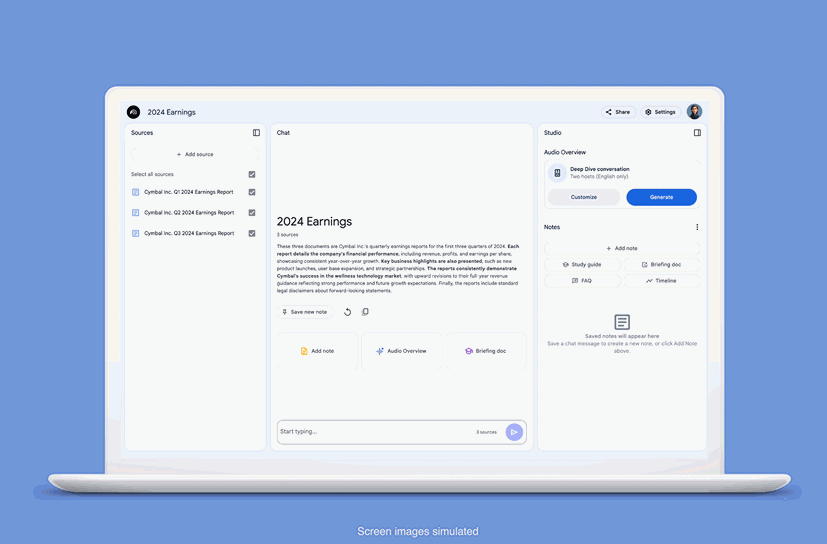Insights

“It would have taken me a year to put together the work you’ve done in 2 months”
SVP, Chief Clinical Officer
In the span of a year, generative AI has leapt from curiosity to boardroom priority. But while enthusiasm has surged, execution often lags.
Many organizations remain stuck in pilot purgatory. They’re running isolated experiments with LLM copilots while struggling to scale value across business units, systems, and security boundaries.
It’s not due to a lack of tools. It’s fragmentation. Data is scattered across silos. Workflows are stitched together across Slack, SharePoint, Salesforce, Jira, and Confluence. And most “enterprise AI” initiatives simply layer a chatbot on top of this chaos.
Google Agentspace offers a different approach. It was designed from the ground up to address the needs of large, security-sensitive organizations. It’s capable of searching, reasoning, automating, and acting across all your company’s systems.
In this article we’ll discuss
- What Agentspace is and how it works
- How companies are deploying it today
- Lessons from early adopters
- Mistakes to avoid
- Practical steps to get started
Planning your first Agentspace use case?
Don’t start from scratch. We’ve created a simple, actionable Agentspace Pilot Planning Canvas to help your team:
- Identify the right starting use case
- Map the data systems and permissions you’ll need
- Choose between prebuilt and custom agents
- Set measurable success metrics
- Launch with guardrails (and stakeholder buy-in)
Perfect for IT leaders, innovation teams, or platform owners looking to move from theory to execution.
What Is Agentspace?

Google Agentspace is a managed service AI platform that provides a centralized enterprise wide interface for google quality enterprise search over internal data, AI reasoning and summarization grounded in user selected data stores, and a common location to deploy agents for automation and decision intelligence workflows. It integrates with more than 100 systems, including Google Workspace, Microsoft 365, Salesforce, ServiceNow, Jira, and more. Agents housed within the Agentspace App can be prebuilt by Google, built within Agentspace using Google’s no-code Agent Designer, or created using agent SDK’s like Google’s Agent Development Kit. And it is deployed in a highly secure environment where access to the Agentspace App and internal data stores is managed by Google Cloud’s built in roles and permissions.
Agentspace Apps are deployed as a full web app. The homepage can be customized for each user displaying calendars, recent files, and other internal information they routinely access. Further personalization and improved search quality and experience by setting up personal knowledge graphs linking people, content, and interactions across the organization**.** All together, Agentspace eliminates knowledge fragmentation. It allows employees to locate and act on information they need in real-time versus the endless hours spent browsing multiple file folders and dark data sources prevalent in almost all organizations.
What distinguishes Agentspace isn’t just its capabilities, but the design principles behind it:
- Security by default: All data interactions respect role-based access control (RBAC), IAM configurations, VPC Service Controls, customer-managed encryption keys (CMEK), and Access Control Lists. Customer data and customer interactions with Agentspace are never used to train Google models.
- Multimodal intelligence: Agents can process and generate across text, audio, images, video, and code, natively integrating tools like Imagen and Veo.
- Cross-agent interoperability: Through the emerging MCP and Agent2Agent protocols, agents from different vendors or business units can collaborate, unlocking end-to-end automation even in complex enterprise environments.
How Organizations Are Deploying Agentspace
While every organization is different, some common early best practices have started to emerge:
Phase 1: High-Impact Use Case Identification
Effective deployments usually begin with focused discovery. Leading adopters like Gordon Food Services and KPMG started by identifying business processes where information retrieval or manual knowledge work slows down decision-making. Generating customer briefs, responding to RFPs, onboarding new hires, or reconciling compliance data are all examples.
These companies avoid the temptation to automate everything. Instead, they select 1–2 use cases with clear value potential and measurable outcomes.
Phase 2: Integration of Key Systems
Connecting enterprise systems is a critical early step. Organizations typically begin by ingesting data from core collaboration platforms like Google Drive, SharePoint, Slack, and Confluence. Sensitive systems (Salesforce, SAP, or Jira, etc.) are brought in with careful attention to access permissions and group-based visibility.
Agentspace connectors respect existing identity provider configurations (e.g., Okta, Azure AD), mirroring group-level ACLs. This prevents both underexposure (users can't find what they need) and overexposure (risk of data leaks), a challenge common in early GenAI pilots.
Phase 3: Layered Training and “Shadow Mode”
Training is delivered across three audiences:
- Business leaders are equipped to identify use case opportunities and interpret outputs.
- End users learn when and how to invoke agents within their workflows.
- Technical teams handle connector maintenance, custom agent creation, and monitoring.
Some organizations adopt a “shadow mode” approach, running agents alongside humans before enabling full automation. This A/B model builds user confidence, captures edge cases, and trains teams in oversight best practices.
Phase 4: Custom Agent Development and Governance
Google provides both a no-code Agent Designer and an SDK for building bespoke agents. Through the Vertex AI Agent Engine, most third party tools are also available such as LangGraph and CrewAI. Enterprises are using these tools to design role-specific agents, like a finance forecast validator, an HR policy responder, or a project planning assistant.
Custom agents can be deployed to managed services such as Google Cloud Run or Vertex AI Agent Engine. These services allow employees to browse and launch agents by function, department, or task. They also include a full suite of monitoring, logging, and evaluation tools. This helps avoid the “rogue agent” problem seen in less governed AI platforms.
Enterprises also establish review and approval policies for agent behavior, data access, and versioning, with auditability built in via Access Transparency logs and Cloud IAM policies.
Early Results and Business Impact
Enterprises that have deployed Agentspace at scale report substantial productivity gains. For example:
- **40% reduction in time spent on routine knowledge work**, such as searching across systems, formatting content, or gathering inputs from different teams.
- 60% faster turnaround for research-heavy tasks, like market briefs, competitive analyses, or compliance reviews.
- Significant reductions in context switching, with users able to stay in a single interface instead of toggling across apps.
In one implementation scenario, sales teams consolidated CRM and roadmap data to auto-generate custom pitch decks—turning hours of manual work into minutes.
HR departments have also used agents to field common onboarding questions, like PTO and benefits, reducing internal support loads by as much as 75%, according to sample workflows showcased by Google.
Notably, these results only materialized where implementation was supported by governance, clear process alignment, and strong stakeholder ownership.
Pitfalls That Undermine Adoption
Agentspace is powerful, but only if implemented with discipline. Common missteps include:
- Over-scoping early pilots: Trying to automate too many processes at once can stall momentum. The most successful implementations began with one or two high leverage workflows.
- Neglecting change management: Even the most capable agent won’t be used if employees don’t trust it. Without education and rollout plans, usage lags. Bake change management, training, and up-skilling into your rollout plan.
- Insufficient validation and monitoring: Organizations that skipped shadow mode risked unreviewed agent outputs reaching customers or stakeholders, eroding trust in the platform.
- Misconfigured access controls: Failing to align ACLs across systems either frustrates users or leads to data leakage. Both are preventable with proper setup.
- Failure to assign ownership: Without a dedicated product owner or platform steward, updates stagnate, user questions go unanswered, and agents will grow stale.
In short, all the normal rules of change management with digital transformation initiatives apply here too.
A Structured Approach to Scaling Success
Agentspace is not a “switch you flip.” But with a clear plan, its benefits compound quickly. A typical rollout might follow this arc:
- Assess & Prioritize. Run an AI readiness discovery. Identify 1–2 business-critical workflows where AI could save time or increase accuracy.
- Connect Data Sources. Begin with a small set of systems (Drive, Jira, Salesforce, etc.),ensuring ACLs and identities are mapped correctly.
- Pilot Prebuilt Agents. Use Google’s out-of-the-box research or summarization agents to drive early wins without custom builds.
- Develop Custom Agents. Create simple workflow agents using Agent Designer. Introduce Vertex AI for more complex orchestration later.
- Deploy with Guardrails. Launch in shadow mode. Monitor usage, validate outputs, and slowly increase agent responsibility.
- Document, Iterate, Scale. Build a central gallery. Train champions. Celebrate wins. Scale by department and measure impact continuously.
Looking Ahead: AI Infrastructure, Not AI Assistant
Google Agentspace isn’t just another enterprise AI search bar. It’s a shift in how knowledge work happens, blending discovery, understanding, and execution in a single interface.
When deployed thoughtfully, it enables a new operating model for modern organizations. Knowledge becomes navigable, decisions become faster and more informed, routine work becomes automated and auditable, and employees focus more on strategy.
If your organization is serious about integrating generative AI into daily operations securely, Agentspace represents a fantastic option to consider.
Ready to Explore?
We offer focused, half-day Agentspace workshops designed to help you:
- Evaluate use cases
- Map your current systems and workflows
- Launch a pilot with measurable outcomes
- Build a blueprint for scale
Contact us to learn more.
Partner with Us
In today’s data-driven landscape, the ability to harness and transform raw data into actionable insights is a powerful competitive advantage.
Making better decisions leads to measurably better outcomes. With a solid data and AI foundation, businesses can innovate, scale, and realize limitless opportunities for growth and efficiency.
We’ve built our Data & AI capabilities to help empower your organization with robust strategies, cutting-edge platforms, and self-service tools that put the power of data directly in your hands.
Self-Service Data Foundation
Empower your teams with scalable, real-time analytics and self-service data management.
Data to AI
Deliver actionable AI insights with a streamlined lifecycle from data to deployment.
AI Powered Engagement
Automate interactions and optimize processes with real-time analytics and AI enabled experiences.
Advanced Analytics & AI
Provide predictive insights and enhanced experiences with AI, NLP, and generative models.
MLOps & DataOps
Provide predictive insights and enhanced experiences with AI, NLP, and generative models.
Recent Insights

Healthcare
Data-Driven Development of a Patient Engagement Application
We partnered with a healthcare provider to build a scalable patient engagement app with real-time insights and secure document management. Leveraging advanced data analytics, the platform ensured continuous improvement in patient care and operations.

Professional Services
Navigating Trust in Emerging Technologies
A multinational firm analyzed public sentiment on emerging technologies using AI and NLP. The insights revealed privacy concerns and opportunities, helping the client prioritize investments in ethical practices and transparency.
Ready to embrace transformation?
Let’s explore how our expertise and partnerships can accelerate impact for your organization.



